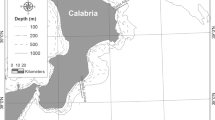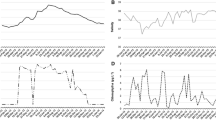Abstract
Morphometric measurements of the gut cells of the marine calanoid copepod Acartia tonsa were made over a 24 h diel cycle to test the hypothesis that feeding rhythms in this copepod are limited by the cycles of blishter-like cells (B-cells) in the gut. Copepods were collected from Long Island Sound, New York, USA, in June 1991. Experimental treatments included low (1 μg chlorophyll al-1) and high (10 μg chlorophyll al-1) food concentrations. Copepods were fixed and embedded in Epon at six time intervals over the 24 h period, and semi-thin sections through the length of Midgut Zone II were analyzed for gut-cell area and vacuole area, with area measurements integrated to yield estimates of gut-cell volume and vacuole volume. Concurrent measurements of gut fluorescence, a measure of gut fullness, and digestive enzyme activities also were made. A diel cycle in gut fluorescence was observed, most notably in the low-food treatment, which exhibited a 3-fold increase in gut pigments. There was little consistent change in digestive enzyme activities over this time span. Gaps in the gut wall indicative of spent B-cells were observed in 17 of 39 copepods, with no trend over time or food treatment. Generally, only a single gap was seen in any one copepod. B-cells were vacuolated throughout the 24 h period. Morphometric analyses revealed a correlation between gut fluorescence and both maximum vacuole area and vacuole volume, as well as percent vacuolated cell volume, in the low-food treatment. The high-food treatment, which had a relatively smaller increase in gut fluorescence (1.5-fold) during the night cycle, showed no significant increase in vacuole size. B-cells appear to have a life-cycle greater than the diel feeding period, and while B-cell vacuoles respond to the ingested food during the diel cycle, production of B-cells does not appear to be a limiting factor in A. tonsa's feeding cycle.
Similar content being viewed by others
References
Al-Mohanna SY, Nott JA (1986) B-cells and digestion in the hepatopancreas of Penaeus semisulcatus (Crustacea: Decapoda). J mar biol Ass UK 66: 403–414
Al-Mohanna SY, Nott JA (1987) R-cells and the digestive cycle in Penaeus semisulcatus (Crustacea: Decapoda). Mar Biol 95: 129–137
Arnaud J, Brunet M, Mazza J (1978) Studies on the midgut of Centropages typicus (Copepoda, Calanoid). I. Structural and ultrastructural data. Cell Tissue Res 187: 333–353
Arnaud J, Brunet M, Mazza J (1980) Structure et ultrastructure comparées de l'intestin chez plusiers espèces de copépodes calanoides (Crustacea). Zoomorphologie 95: 213–233
Baars MA, Oosterhuis SS (1984) Diurnal rhythms in grazing on labelled food, gut fluorescence, and digestive enzyme activities of North Sea copepods. Neth J Sea Res 18: 97–119
Båmstedt U (1984) Diel variations in the nutritional physiology of Calanus glacialis from Lat. 78°N in the summer. Mar Biol 79: 257–267
Billingsley PF (1988) Morphometric analysis of Rhodinus prolixus Stal (Hemiptera: Reduviidae) midgut cells during blood digestion. Tissue Cell 20: 291–301
Boyd CM, Smith ML, Cowles TJ (1980) Grazing patterns of copepods in the upwelling system off Peru. Limnol Oceanogr 25: 583–596
Boucher J, Samain JF (1974) L'activité amylasique, indice de nutrition du zooplancton; mise en evidence d'un rythme quotidien en zone d'upwelling. Téthys 6: 179–188
Dagg MJ (1977) Some effects of patchy food environments on copepods. Limnol Oceanogr 22: 99–107
Dagg MJ (1985) The effects of food limitation on diel migratory behavior in marine zooplankton. Arch Hydrobiol (Beih Ergebn Limnol) 21: 247–255
Dagg MJ, Frost BW, Walser WE Jr (1989) Copepod diel migration, feeding, and the vertical flux of phaeopigments. Limnol Oceanogr 34: 1062–1071
Dagg MJ, Grill DW (1980) Natural feeding rates of Centropages typicus females in the New York Bight. Limnol Oceanogr 25: 597–609
Durbin EG, Durbin AG (1991) Effects of temperature and food abundance on grazing and short-term weight change in the marine copepod Acartia hudsonica. Limnol Oceanogr 37: 361–378
Durbin AG, Durbin EG, Wlodarczyk E (1990) Diel feeding behavior in the marine copepod Acartia tonsa in relation to food availability. Mar Ecol Prog Ser 68: 23–45
Erlanger BF, Kokowsky N, Cohen W (1961) The preparation and properties of two new chromogenic substrates of trypsin. Biochem biophys Acta 95: 271–278
Gauld DT (1953) Diurnal variations in the grazing of planktonic copepods. J mar biol Ass UK 31: 461–474
Hassett RP, Landry MR (1982) Digestive carbohydrase activities in individual marine copepods. Mar Biol Lett 3: 211–221
Hassett RP, Landry MR (1988) Short-term changes in feeding and digestion by the copepod Calanus pacificus. Mar Biol 99: 63–74
Hayward TL (1980) Spatial and temporal feeding patterns of copepods from the North Pacific central gyre. Mar Biol 58: 295–309
Head EJ (1986) Estimation of Arctic copepod grazing rates in vivo and comparison with in-vitro methods. Mar Biol 92: 371–379
Head EJH, Harris LR, Abou Debs C (1985) Effects of daylength and food concentration on in situ diurnal feeding rhythms in Arctic copepods. Mar Ecol Prog Ser 24: 281–288
Head EJH, Wang R, Conover RJ (1984) Comparison of diurnal feeding rhythms in Temora longicornis and Centropages typicus with digestive enzyme activity. J Plankton Res 6: 543–551
Hecker H, W Rudin (1981) Morphometric parameters of the midgut cells of Aedes aegypti L. (Insecta, Diptera) under various conditions. Cell Tissue Res 219: 619–627
Hirche H-J (1983) Overwintering of Calanus finmarchicus and C. helgolandicus. Mar Ecol Prog Ser 11: 281–290
Hopkin SP, Nott JA (1980) Studies on the digestive cycle of the shore crab Carcinus maenus (L.) with special reference to the B-cells in the hepatopancreas. J mar biol Ass UK 60: 891–907
Karnovsky MJ (1965) A formaldehyde-glutaraldehyde fixative of high osmolarity for use in electron microscopy. J Cell Biol 27: 137A-138A
Kiørboe T, Möhlenberg F, Hamburger K (1985) Bioenergetics of the planktonic copepod Acartia tonsa: relation between feeding, egg production, and respiration, and the composition of specific dynamic action. Mar Ecol Prog Ser 26: 85–97
Kiøboe T, Tiselius PT (1987) Gut clearance and pigment destruction in a herbivorous copepod, Acartia tonsa, and the determination of in situ grazing rates. J Plankton Res 9: 525–534
Kleppel GS, Pieper RE, Trager G (1988) Variability in the gut contents of individual Acartia tonsa from waters off Southern California. Mar Biol 97: 185–190
Lorenzen CJ (1966) A method for the continuous measurement of in vivo chlorophyll concentration. Deep-Sea Res 13: 223–227
Mackas D, Bohrer R (1976) Fluorescence analysis of zooplankton gut contents and an investigation of diel feeding patterns. J exp mar Biol Ecol 25: 77–85
Mackas DL, Burns KE (1986) Poststarvation feeding and swimming activity in Calanus pacificus and Metridia pacifica. Limnol Oceanogr 31: 383–392
Mayzaud O, Mayzaud P, de la Bigne C, Grohan P, Conover RJ (1984) Diel changes in the particulate environment, feeding activity, and digestive enzyme concentration in neritic zooplankton. J exp mar Biol Ecol 84: 15–35
Mayzaud P, Poulet SA (1978) The importance of the time factor in the response of zooplankton to varying concentrations of naturally occuring particulate matter. Limnol Oceanogr 23: 1144–1154
Mayzaud P, Roche-Mayzaud O, Razouls S (1992) Medium-term acclimation of feeding and of digestive enzyme activity in marine copepods: influence of food concentration and copepod species. Mar Ecol Prog Ser 89: 197–212
Nott JA, Corner EDS, Mavin LJ, O'Hara SCM (1985) Cyclical contributions of the digestive epithelium to faecal pellet formation by the copepod Calanus helgolandicus. Mar Biol 89: 271–279
Paffenhöfer G-A (1994) Variability due to feeding activity of individual copepods. J Plankton Res 16: 617–626
Paffenhöfer G-A, Stearns DE (1988) Why is Acartia tonsa (Copepoda: Calanoida) restricted to nearshore environments? Mar Ecol Prog Ser 42: 33–38
Richardson KC, Jarett L, Finke EH (1960) Embedding in epoxy resins for ultrathin sectioning in electron microscopy. Stain Technol 335: 313–323
Roche-Mayzaud O, Mayzaud P, Biggs DC (1991) Medium-term acclimation of feeding and of digestive and metabolic enzyme activity in the neritic copepod Acartia clausi. I. Evidence from laboratory experiments. Mar Ecol Prog Ser 69: 25–40
Rodriguez V, Durbin EG (1992) Evaluation of synchrony of feeding behaviorin individual Acartia hudsonica (Copepoda: Calanoida). Mar Ecol Prog Ser 87: 7–13
Stearns DE (1986) Copepod grazing behavior in simulated natural light and its relation to nocturnal feeding. Mar Ecol Prog Ser 30: 65–76
Storch V, Anger K (1983) Influence of starvation and feeding on the hepatopancreas of larval Hyas araneus (Decapoda, Majidae). Helgoländer Meeresunters 36: 67–75
Tande KS, Slagstad D (1982) Ecological investigation on the zooplankton community of Balsfjorden, northern Norway. Seasonal and short-time variations in enzyme activity in copepodite stage V and VI males and females of Calanus finmarchicus (Gunnerus). Sarsia 67: 63–68
Thompson AM, Durbin EG, Durbin AG (1994) Seasonal changes in maximum ingestion rate of Acartia tonsa in Narragansett Bay, Rhode Island, USA. Mar Ecol Prog Ser 108: 91–105
Turner JT, Tester PA, Strickler JR (1993) Zooplankton feeding ecology: a cinematographic study of animal-to-animal variability in the feeding behavior of Calanus finmarchicus. Limnol Oceanogr 38: 255–264
Author information
Authors and Affiliations
Additional information
Communicated by M.F. Strathmann, Friday Harbor
Rights and permissions
About this article
Cite this article
Hassett, R.P., Blades-Eckelbarger, P. Diel changes in gut-cell morphology and digestive activity of the marine copepod Acartia tonsa . Marine Biology 124, 59–69 (1995). https://doi.org/10.1007/BF00349147
Received:
Accepted:
Issue Date:
DOI: https://doi.org/10.1007/BF00349147




